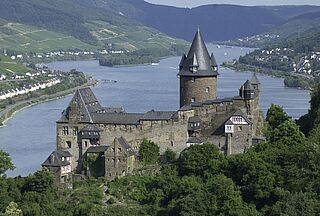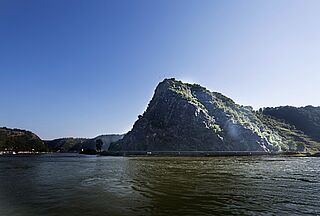Drachenfels
Kendte vinmarker
Drachenfels: Dragon's Cliff at the Northern Gateway to the Romantic Mittelrhein
Drachenfels is the NAME of one of the Siebengebirge (Seven Hills) just south of Bonn and doubtlessly, the best known; the ruins of the 12th-century Burg (fortress) at the peak of the hill; and the vine-covered slope near the foot of the hill that stretches from Königswinter to Rhöndorf this months famous site. Vines have been cultivated near Königswinter at least since Roman times, although the name of the town derives from the Middle Ages, when a succession of Könige (kings) owned Wingerte(vineyards) there – even Charlemagne is said to have had a vineyard on Drachenfels hill. In the aftermath of the German wine law of 1971 (when 26,000 vineyard names were reduced to 2,600), the name Drachenfels was chosen in 1976 as the umbrella term for the parcels formerly known as Domley, Drachenley, and An der Ley, to name but a few. “Ley” or “Lay” alludes to rock formations, often cliff-like and slaty – and appears in many vineyard names in the Mittelrhein, Ahr and Mosel regions. Perhaps the most legendary “Ley” designation is in St. Goarshausen, “Loreley Edel” – named after the blond siren Loreley, whose capitvating beauty and haunting melodies led many an unwary sailor to a watery death in the turbulent waters beneath the “cliff of Loreley.”
Despite its very northerly location (50.683° latitude), the Drachenfels site has an excellent microclimate for viticulture, warmer than that of the surrounding area – not least due to its proximity to the Rhine, its slope (up to 53 percent), and its southerly exposure. Vines are planted at an altitude ranging from 60 to 140 meters above sea level. Although weathered slate is predominant throughout the Mittelrhein as a whole, the soils of Drachenfels are distinctive for their trachyte content, a light-colored volcanic rock that has been prized as a building material since Roman times. In the Middle Ages, trachyte was quarried here to build the cathedral of Cologne. It derives from a volcanic eruption some 18 million years ago, when the Siebengebirge took shape. Trachyte consists of potassium-rich, alkali feldspars, which serve to buffer wine acidity. As such the wines are quite agreeable and not as austere as one might expect from such a northerly vineyard. As in neighboring sites, loam is also a soil component of the Drachenfels site. Portions of the site are extremely stony. In all, these soils absorb and retain heat quite well. To demonstrate how quickly soil types can change from hill to hill: the soils of the sites just north of Drachenfels in Oberdollendorf (the northernmost of the Mittelrhein) are primarily a layer of loam over graywacke, while the soils in the sites immediately south, in Unkel, are loamy, weathered slate. None contain trachyte.
Riesling and Müller-Thurgau are planted here, as well as the Riesling-like Kerner; the spicy varietals Gewürztraminer and Scheurebe; and a small amount of Grauburgunder (Pinot Gris). Red varieties include Portugieser and Spätburgunder.
The vineyard area today is but a fraction of its medieval size. Vineyard consolidation in the 1970s helped improve efficiency, yet vineyard maintenance and harvesting still require a great deal of work by hand – only three estates still produce “Siebengebirge wines” and only two of them have holdings in the Drachenfels site: Weingut A. Pieper owns 9 ha (22 acres) and Weingut Broel, 3 ha (ca. 7.5 acres).
Given the small size of the region – and thus, small quantities produced – Mittelrhein wines are not well known beyond their borders, particularly those produced at the northern tip of the region. Should your travels bring you this way, it’s well worth discovering what these growers have to offer. They work very hard to cultivate their vines and the results merit attention.
Drachenfels is the legendary setting in the Song of the Nibelungs, where Siegfried did battle with the Drache (dragon) that lived in the Drachenhöhle (dragon’s cave) on the hill, and bathed in its blood to make himself invincible. The local red wine specialty Drachenblut(dragon’s blood) alludes to this battle. It’s a light, off-dry quaffing wine made from the Portugieser grape. Weingut A. Pieper has produced it for years. It is quite popular in Japan, and a small amount is exported to England.
Tips for Tourists
Drachenfels is situated in the Naturpark Siebengebirge, Germany’s oldest (1836) nature preserve and today, a national park. Hikers will find a vast network of marked trails here (200 km/124 miles), some of which have been incorporated into the challenging new Rhine hiking trail from Wiesbaden to Bonn (320 km/199 miles), “Der Rheinsteig” that takes in numerous Rheingau and Mittelrhein vineyards along the way.
The best way to reach the ruins of 12th-century Burg Drachenfels and the observation platform just beneath it (fabulous views of the Rhine Valley), is to take Germany’s oldest (1883) cogwheel train, the Drachenfelsbahn. Although the journey is only 1.5 km (nearly a mile), the slope is 22% – and makes for quite an uphill hike on foot.
The train stops halfway up the hill, for those who want to visit other attractions, such as Schloss Drachenburg, a neo-Gothic castle built in 1884 that has been extensively renovated since 1995. In addition to period rooms with furnishings from the 17th to 19th centuries, the Venus Terrace (gardens and fountain) and north tower are good vantage points. Adjacent to the castle is a museum devoted to the history of nature conservation in Germany during the past two centuries.
Not far from the castle is the Nibelungenhalle, with 12 monumental paintings depicting scenes from Wagnerian operas, built in 1913 to commemorate the composer’s 100th birthday. The Drachenhöhle (dragon’s cave) and a reptile zoo are part of the complex.
Note: the train operates year-round, most frequently (every half hour) from May through September. Castles and museums are closed Mondays and the season is usually April through October.
At this writing, the roundtrip ticket on the Drachenfelsbahn train is € 8,00. It makes sense to purchase a Kulturtour-Ticket at the tourist information office in Königswinter (starting point of the cogwheel train trip) for € 9,00 – it includes the train fare as well as admission to the castle and Nibelungenhalle complex.
There are several snackbars and restaurants with terraces on Drachenfels. In Königswinter proper, the Pieper family operates two restaurants that feature their Drachenfels wines: Jesuiter Hof (also has five moderately-priced double rooms) and Altes Fährhaus, with inviting outdoor seating overlooking the Rhine. The wine estate also has a wine pub, Weinhaus am Domstein, and a guesthouse (eight moderately-priced rooms, all with balcony and a view of Drachenfels), Haus Drachenloch – both in the neighboring town of Rhöndorf.
The annual “Rhine in Flames” fireworks display (first Saturday in May) from Bonn to Linz is quite spectacular. Wine festivals: Unkel and Rhöndorf: first weekend of September; Königswinter: first weekend of October.
Many thanks to the Pieper family (www.weingut-pieper.de) for supplying background information and a photo of the vineyard site.


